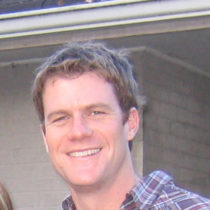Landscape Architecture for Landscape Architects › Forums › SUSTAINABILITY & DESIGN › Landscape Architect’s Role in Renewable Energy, Green Roofs, etc.
- This topic has 1 reply, 11 voices, and was last updated 14 years, 10 months ago by
 Derek James Seifert.
Derek James Seifert.
-
AuthorPosts
-
January 7, 2011 at 4:47 pm #165860
 Ryan A. WaggonerParticipant
Ryan A. WaggonerParticipantWhat is the landscape architect’s role in regards to renewable energies and other sustainable technologies? I would like to hear experiences of being the liason, designer, project manager, etc. of projects involving sustainable technologies or ideas of how we should/could be more involved in the process. These are growing industries and we should be in front of them as a profession, in my opinion. What are we doing as a profession to put ourselves in this position?
January 7, 2011 at 5:57 pm #165883 Derek James SeifertParticipant
Derek James SeifertParticipantExcellent question Ryan, I’m not a person who can answer your question, but for somebody replying to Ryan I would like to add an additional question: If this is the main direction that “sustainability” seems to be moving (removing the element of craft and art and relying simply on engineering and science), then how should we be adapting the academic environment/curriculum of landscape architecture to ensure we are up-to-speed on these issues?
January 7, 2011 at 6:31 pm #165882 Ryan A. WaggonerParticipant
Ryan A. WaggonerParticipantgreat addition derek. i see it more as we should be the people linking these two arenas, art and technology. at least i see LA as a blend of these two abilities….
January 7, 2011 at 10:19 pm #165881 Andrew Garulay, RLAParticipant
Andrew Garulay, RLAParticipantMy only experience with “green energy” has been with wind turbines.None of them have had any additional site treatments that would be “landscape architecture” … not even the traditional “pubic effect” planting often associated with vertical elements in the landscape. Perhaps it is that these are placed in “non-people” places. I’ve done some work on at least four. All were straight forward engineering with no frills.
Only one was near people – a garden center. That was merely placed so that the fall zone was as far away from the abutting properties as possible. The nursery continued to lay out the trees and shrubs around it as if it were just another piece of nursery stock. I don’t see any landscape architecture opportunity directly related to wind turbines.
…. although I did get an email from someone concerned about screening out the as yet unbuilt wind farm in Nantucket Sound. She wanted to know if I could design screening of the turbines while maintaing her water view so that she could plant trees now to get a jump on it. Let’s see, 130 towers 425′ high and four miles off shore ….
January 8, 2011 at 1:54 am #165880 ncaParticipant
ncaParticipantIn my limited and humble experience in the professional world, less ‘sustainable’ projects in general are what have been keeping us afloat. McDonalds, Drive-thru Coffee, Taco Shops, Gas Stations, and even…Oil and Gas Drilling.
I have worked on a few site plans for oil/gas as well as a site plan for ‘sustainable energy uses’ ie PV/Solar, but the drill was pretty much the same–limited budget, meet minimum requirements per code, etc.
I’m sure there are more prestigious energy projects out there, and those I listed are probably unlikely to be those that you are referring to, but perhaps this is the reality. Oil and Gas is still going strong in my neck of the woods, as are cheap and dirty. I’m sure we’ve all heard what a great years McDonalds had last year.
January 12, 2011 at 3:10 pm #165879 ChristaParticipant
ChristaParticipantAs a student I was able to attend the Green Roof Professional training offered by Green Roofs for Healthy Cities (http://www.greenroofs.org/index.php/eduprogram/grnroofpro-grp). It was offered over about 2 weeks, and covered some really technical details about roof construction, as well as some of the issues to be dealt with in a green roof design. I found it to be pretty exhaustive, and was impressed by the number of roofing professionals in attendance. It was a small class, less than 15 attendees, but I was the only landscape architect.
January 13, 2011 at 5:56 pm #165878 kittycooksParticipant
kittycooksParticipant@Christina, I’ve toured green roofs. That was the first thing I thought of when I read Ryan’s post. The MNU Landscape Arboretum has recently completed a large geothermal project which involves routing the pipes through the main parking lot. http://www.arboretum.umn.edu/geothermalheatingandcooling.aspx
There is a lot of interest in geothermal systems at the local home and garden shows. Landscape architects and designers could benefit from relationships with these companies and offer professional advice for aesthetic placement of the underground pipes. A home in my neighborhood had their system routed through the whole front and side yard and covered it with sod. There was no planning for trees, shrubs or patio and the lot looks barren.
January 14, 2011 at 6:10 pm #165877 Cole ThompsonParticipant
Cole ThompsonParticipantThough I have limited experience with professional renewable energy projects, as a landscape designer I think there is great potential there. It is clear that we are seeing more green infrastructure in the landscape, and thus an opportunity to implement traditional landscape design and planning around those installations. Why not? Regardless of whether it’s a requirement now, it seems decision makers and energy developers alike will start to lean on landscape architects to help integrate these projects into the urban and rural fabric.
January 14, 2011 at 6:11 pm #165876 Ryan A. WaggonerParticipant
Ryan A. WaggonerParticipantcome join the chat!
January 14, 2011 at 6:19 pm #165875 Cole ThompsonParticipant
Cole ThompsonParticipantthought i was chatting.. ;]
January 14, 2011 at 6:20 pm #165874 Ryan A. WaggonerParticipant
Ryan A. WaggonerParticipanthaha, yup…should’ve checked that first!
January 14, 2011 at 9:11 pm #165873 Rex RedmonParticipant
Rex RedmonParticipantIt seems to me you are addressing two uniquely different issues in one broad stroke. Green Roofs have nothing to do with renewable energy but everything to do with Landscape Architecture. Landscape Architect’s role in a biomass generation plant may be protesting it’s construction but certainly not acting as the prime consultant. Without question storm water management is an area that Landscape Architects need to reclaim from the engineers. Our office has been having issues with solar panels conflicting with tree plantings in tight site situations and low rise buildings. This causes problems especially since the areas of the site needing the most shade are the sides which the panels face.
The place LA’s could have the biggest impact in the short term is getting the USGBC to aknowledge our existence. The LEED rating system has been a giant step backwards for ecologically sensitive landscape design in many ways. Until more LA’s get involved in how the standards are written and get more points included with more refined nuances, the giant hammer cracking a small nut approach will continue to plague us.
January 14, 2011 at 9:35 pm #165872Stephen Quick
ParticipantThere are really quite a lot of boundary-pushing technologies out there for sustainability…but they require at least a basic understanding of science and engineering to utilize them effectively in landscape architecture. In my experience, many instructors will encourage students to consider using solar panels, wind turbines, green roof systems, etc., without giving the students an effective understanding of how these technologies work.
I’ve seen countless student presentations that incorporate solar panels (either as roofing replacement or shade structures), and not one of them could tell me how much power their installation would actually generate.
January 22, 2011 at 10:45 am #165871 ChristaParticipant
ChristaParticipantI agree. If we want to effectively compete with technical professions in the technical realm, we need better coverage of this material in school. Everything seems to have some aspect that requires some technical proficiency for the design to be a success, from materials to soils. I know that school is generally supposed to be an introduction to the field, more than an all-encompassing packaging of a profession; It’s just not possible to fit everything into a 3 or 5 year study. However, a better understanding of the complexities behind the design would be a subtle but significant change.
January 22, 2011 at 5:02 pm #165870 Andrew Garulay, RLAParticipant
Andrew Garulay, RLAParticipantEverything starts from where people go first to get whatever type of work they need done designed. Any time that we have expectations to be a part of something we need to be realistic as to not only what we can do, but where in the process we actually fit in from the client’s perspective. I believe that it is unrealistic to expect anyone to contact a landscape architect at the beginning of a wind turbine project or solar farm. We can definitely contribute when there is more to the project than just energy infrastructure, but I’m not sure how having more knowledge of green energy is going to make a difference in getting that work.
Electric utility companies and manufacturers of the energy plant (turbines or panels) are going to be contacted first. Their people will be involved in site selection, civil engineers/surveyors will be brought in next to finalize the location(s) and design or assist in designing the infrastructure to make it all work and get through permitting. That won’t change if landscape architects get more education focused on green energy.
The only thing left is integrating the infrastructure into the context in which it is being built. That is something that we are already trained and experienced in. This is where opportunity is for landscape architects in green energy. It won’t be on every project, just the ones where the context of the site goes beyond infrastructure.
I would really hate to see the education of landscape architects get spread thinner and thinner by concentrating on areas where we simply are not going to be positioned to benefit from that added burden. Universities will eat it up because it gives them a whole new demographic to add to their enrollment, but I don’t believe they’ll be scooped up to work in renewable energy.
Green roofs are another story altogether. I’m not sure that this is really a green energy issue or just an aesthetic and PR segment of the green revolution. Is it a big market or just that every green roof project gets lots of press? I don’t know. It might be great if one or two universities made a specialized curricullum for it, but making it a big issue with a lot of time devoted to it in every LA program would be a very questionable direction in my opinion.
Wind turbine projects are not even a boon for civil engineers. I have worked on several in a couple of different CE offices. We are pretty much left with making a topo plan of the already selected site, fitting the pre-designed turbine where they want it, drawing a basic site plan, the construction staking, and an as-built plan. That is it.
-
AuthorPosts
- You must be logged in to reply to this topic.


